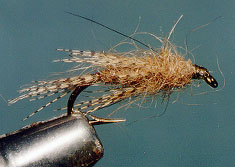|
|
 |
 |
Bird’s Nest Nymph (with bead)
Here is another of
Cal Bird’s patterns. It is a true fish-fooler, and one that is a fly
box staple. It can be tied in any number of colors; my favorite is
the olive version, light or dark. Gray is also a good color. It can
resemble a mayfly nymph caught in the drift; or it can represent a
free-living caddis larva in a migratory drift. |
|
Materials
Hook: Tiemco 200R; Daiichi 1270, #12-18 Thread: Olive 6/0 or 8/0 Head: Gold bead, size to match hook Tail: Wood duck flank feather barbules Abdomen: Olive dubbing--beaver, hare’s ear, muskrat, or rabbit Hackle: Wood duck flank feather barbules Thorax: Same as abdomen Rib: Copper wire, fine Weight: Lead or substitute |
|
|
Instructions
1. Place bead on bare hook; secure by placing a few wraps of lead of proper size behind bead, and jamming the lead into the large bevel of the bead, which should be facing rearward. 2. Secure lead with thread wraps and advance thread to rear of hook. 3. At a point just above back end of barb, tie on a tail consisting of a small bunch of wood duck feather fibers cut from the stem. It should be about 2/3 of length of shank. 4. Now tie in the copper wire which will serve as the ribbing, at the same point. 5. Dub a slender abdomen, taking the dubbing 2/3 of the way up the hook shank. Counter-wrap the copper ribbing with a few close wraps, and tie this off in front of the dubbing. 6. From a wood duck flank feather cut out a small portion of the tip of the feather by cutting the stem. Place this piece on top of the hook, with the tips facing rearward. Take a loose wrap around the entire piece right at the front of the dubbed , drawing the thread tight with a second wrap. The effect will be to distribute the barbules evenly around the abdomen if done properly. 7. Take a few more wraps, then let the bobbin hang. Grab the stem and gently pull forward in order to achieve the proper length of the barbule “hackle”. Once this is done, tie it down tightly. The hackle should extend no further back than the point of the hook. 8. Now dub a thorax in front of the hackle, up to the back of the bead; the thorax should be a bit fuller than the abdomen. Whip finish behind the bead.
Fish this beauty on a dead drift under an indicator, and watch for subtle takes. See ya on the creek!!!! |
|
Copyright 1998 by Granite Bay Flycasters unless otherwise noted.
